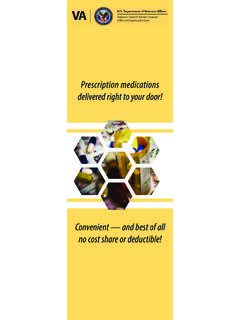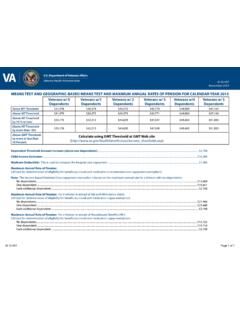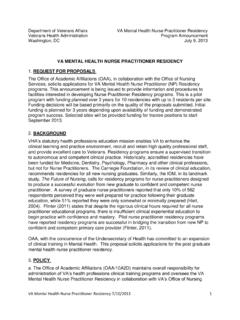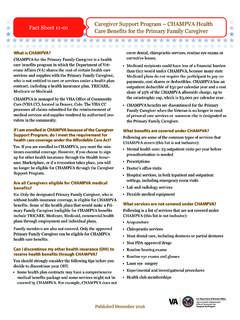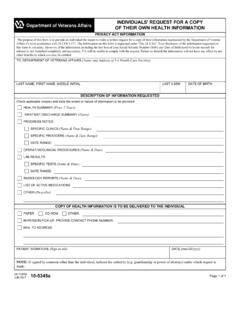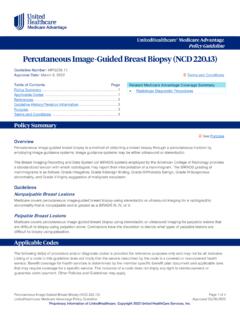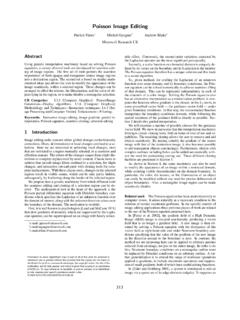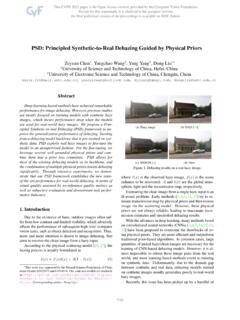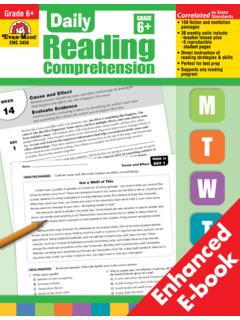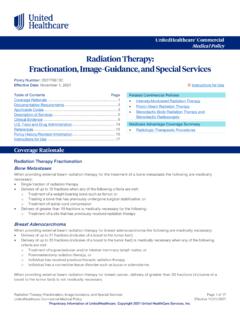Transcription of GUIDED IMAGERY - Veterans Affairs
1 GUIDED IMAGERY . WHAT IS IT? GUIDED IMAGERY is a mind-body approach that uses the mind's eye one's internal processes to support healing. It is closely related to hypnosis, psychotherapy, and biofeedback, which may also incorporate the use of images as part of therapy. Also known as GUIDED visualization, this mind-body practice has been used throughout history to change behaviors, perspectives, and physiology.[1]. HOW IT WORKS. A typical session might start with a person being GUIDED through relaxation exercises. After that, the clinician and the patient begin exploring visual images, as the clinician offers various cues. Initially, a positive image might be created to help the patient relax more; for example, they may be encouraged to visit a safe or beautiful place.
2 Sometimes the patient comes up with the image , and sometimes the practitioner does. Most often, they collaborate. Ultimately, GUIDED IMAGERY is controlled by the person experiencing it. This allows for a sense of mastery and control, which can fuel self-directed change efforts.[2]. GUIDED IMAGERY promotes an altered state of awareness. It is a means by which a person can communicate with their subconscious, or unconscious, mind. Images can distract from pain, as people work with and even alter IMAGERY related to their discomfort; a person may visualize a change in the pain's color, or replace the pain with a different feeling, such as warmth. IMAGERY can also induce relaxation and help people cope more effectively with stress.
3 As they are working with an image , a person is encouraged to be very descriptive and to use all their senses. They are also encouraged to note emotions that arise. Different people gravitate more to focusing on senses. IMAGERY can affect almost all major physiologic control systems of the body, including[3]: Respiration, heart rate, and blood pressure Metabolic rate Digestive system motility and secretion Cortisol (stress hormone) levels Cholesterol levels Immune system activity Mood, including levels of anxiety and depression HOW TO USE IT. IMAGERY can be taught one-on-one or in groups. A practitioner may record a session so that their patient/client will be able to do a given activity or exercise repeatedly.
4 GUIDED IMAGERY IMAGERY can be used to bring about general stress reduction, to focus on a specific outcome, and to gain insight, particularly by interactively exploring IMAGERY . A person might intentionally shift the IMAGERY , and in so doing, shift what the IMAGERY represents. WHEN TO USE IT. According to the VA HSR&D group, based on a large-scale review of all IMAGERY related studies up to March 2018, There is moderate-level confidence that GUIDED IMAGERY is effective in improving diagnosis-related outcomes in patients with arthritis or other rheumatic diseases. The levels of confidence of GUIDED IMAGERY 's effectiveness for other conditions was generally low, due to heterogeneity among the intervention modalities, high risk of bias, lack of blinding, and limited generalizability in some studies.
5 [4]. While more study is clearly needed, GUIDED IMAGERY has shown particular promise with the following (noting that studies have their limitations)[5-7]: Anxiety (in multiple conditions) Pain, including from arthritis and Cancer: Better outcomes with other rheumatic diseases chemo- and radiotherapies Parkinson's disease tremors[8]. Childbirth Post-operative pain Depression Preparation for surgery or Fatigue procedures Improving athletic performance Speed up fracture and burn healing Reducing blood pressure, Stress management cholesterol, and A1c levels Tobacco abstinence Managing chronic illness in general Weight loss Nightmares A 2019 study found that a combination of PMR and Interactive GUIDED IMAGERY significantly reduced stress in cancer patients.
6 [9]. It is possible for nearly anyone to use this technique. Some people prefer to work with a trained professional if they are using IMAGERY to guide them through a physical or mental health issue. Professionals can teach patients to do ongoing work on their own. CDs and online downloads with IMAGERY exercises are widely available. Refer to the Resources section at the end of this document for more information. WHAT TO WATCH OUT FOR (HARMS). GUIDED IMAGERY is not advised (or should be used with extreme care) for individuals who have psychosis, hallucinations, delusions, delirium, dementia, religious beliefs that might be in conflict with the use of IMAGERY , or a history of unprocessed trauma that might come up during the session.
7 VA Office of Patient Centered Care and Transformation. Page 2 of 4. GUIDED IMAGERY TIPS FROM YOUR WHOLE HEALTH COLLEAGUES. A number of organizations offer information about GUIDED IMAGERY online. The VA Whole Health Mobile Apps and Online Tools suggests Health Journeys for GUIDED IMAGERY -related blogs and online IMAGERY sessions. RESOURCES. VA WHOLE HEALTH AND RELATED SITES. Integrative Health Coordinating Center SharePoint on GUIDED IMAGERY : Evidence Map of GUIDED IMAGERY : anagementBriefsMenu=eBrief- no153&eBriefTitle= GUIDED + IMAGERY %2C+Biof eedback%2C+and+Hypnosis o Compilation of systematic review data by VA Health Services Research and Development (HSR&D). CIH Listservs.
8 To be added, contact: o GUIDED IMAGERY listserv: o Other listservs: National CIH Subject Matter Experts, as of FY 2020: o GUIDED IMAGERY : David Gaffney. OTHER WEBSITES. Academy of GUIDED IMAGERY Dartmouth College Student Wellness Center. Offers a variety of short GUIDED meditation exercises, as well as others for relaxation and GUIDED IMAGERY . Health Journeys. Numerous resources involving GUIDED IMAGERY for various health issues and scenarios Health Journeys GUIDED IMAGERY Audio Library. Available as a free podcast. BOOKS. GUIDED IMAGERY for Groups, Andrew Schwartz (1997). GUIDED IMAGERY for Self-Healing, Martin Rossman (2000). AUTHOR(S). Biofeedback was written by Shilagh Mirgain, PhD and Janice Singles, PsyD.
9 (2014, updated 2016). VA Office of Patient Centered Care and Transformation. Page 3 of 4. GUIDED IMAGERY This Whole Health tool was made possible through a collaborative effort between the University of Wisconsin Integrative Health Program, VA Office of Patient Centered Care and Cultural Transformation, and Pacific Institute for Research and Evaluation. REFERENCES. 1. Micozzi M, ed Fundamentals of Complementary and Alternative Medicine. 4th ed. St. Louis, MO: Sunders Elsevier; 2011. 2. Naperstek B. healthjourneys. Accessed February 4, 2020. 3. Trakhtenberg EC. The effects of GUIDED IMAGERY on the immune system: A critical review. Int J Neurosci. 2008;118(6):839-855. 4. Department of Veterans Affairs .
10 Management eBrief no. 153. 2019;. anagementBriefsMenu=eBrief-no153 Accessed July 23, 2019. 5. Giacobbi PR, Jr., Stabler ME, Stewart J, Jaeschke AM, Siebert JL, Kelley GA. GUIDED IMAGERY for arthritis and other rheumatic diseases: a systematic review of randomized controlled trials. Pain Manag Nurs. 2015;16(5):792-803. 6. Naparstek B. Invisible Heroes: Survivors of Trauma and How They Heal. Bantam;. 2005. 7. McKinney CH, Honig TJ. Health outcomes of a series of bonny method of GUIDED IMAGERY and music sessions: a systematic review. J Music Ther. 2017;54(1):1-34. 8. Schlesinger I, Benyakov O, Erikh I, Suraiya S, Schiller Y. Parkinson's disease tremor is diminished with relaxation GUIDED IMAGERY .
